
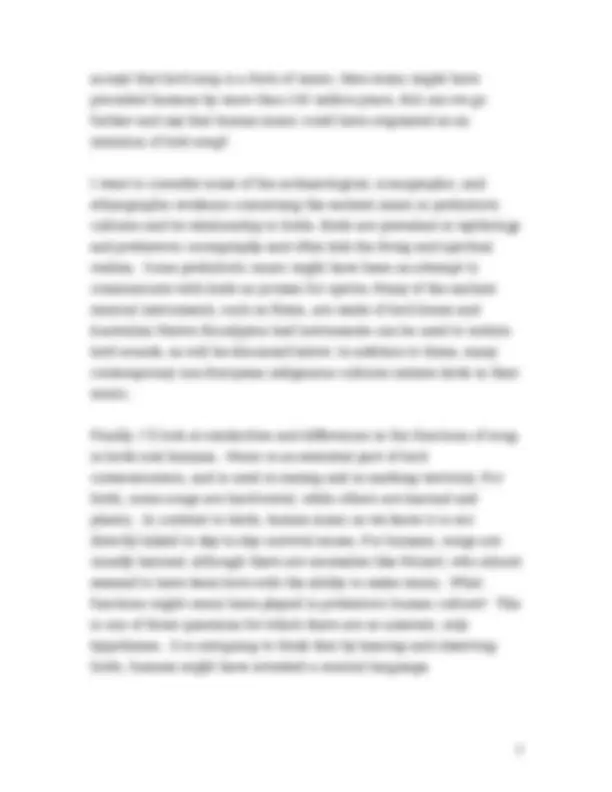
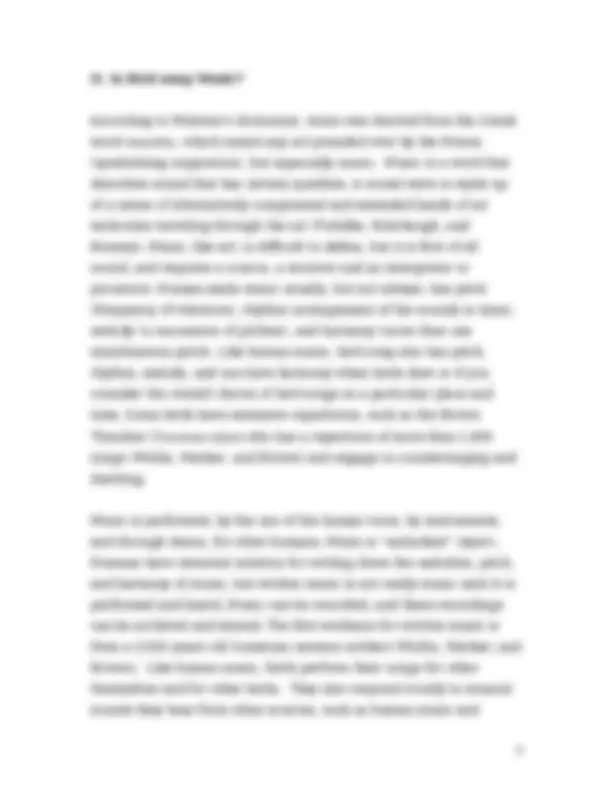
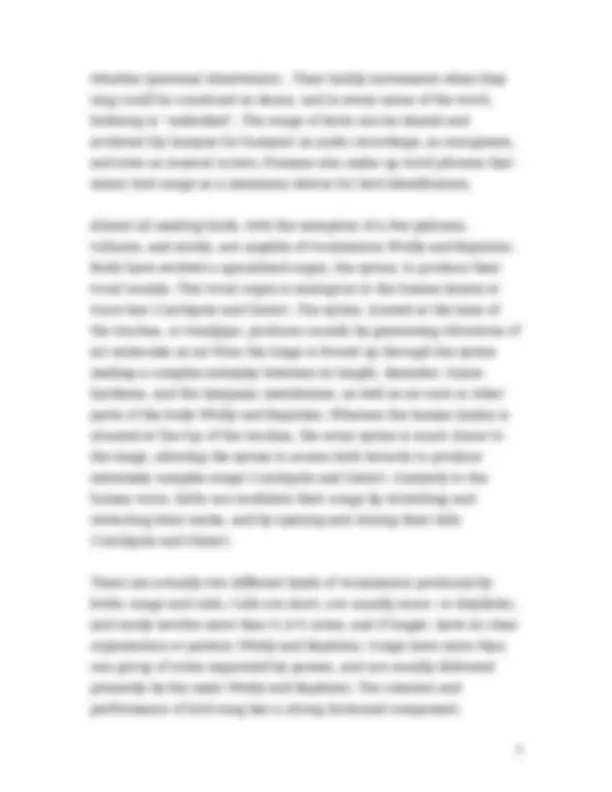
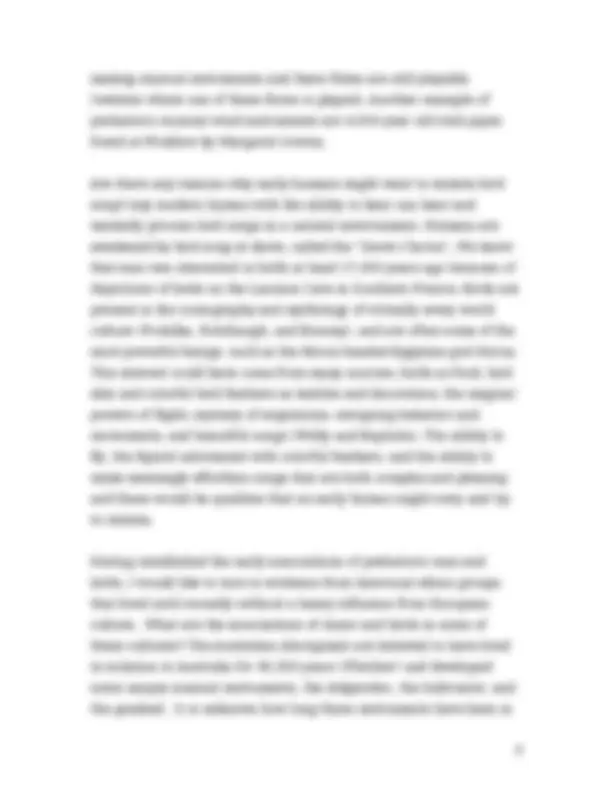
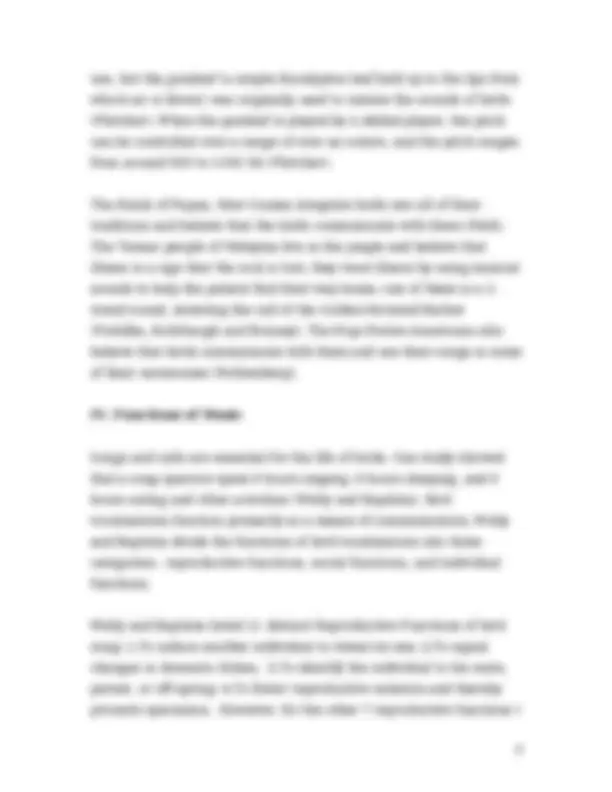
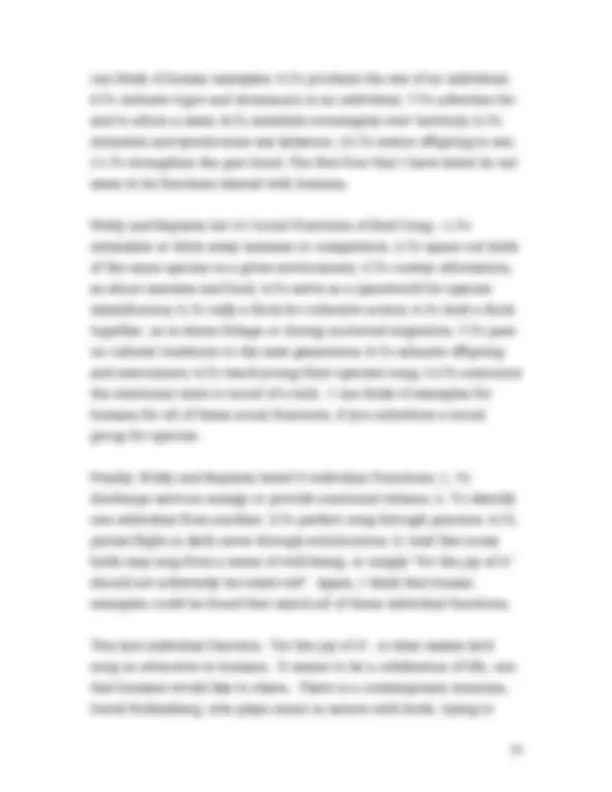
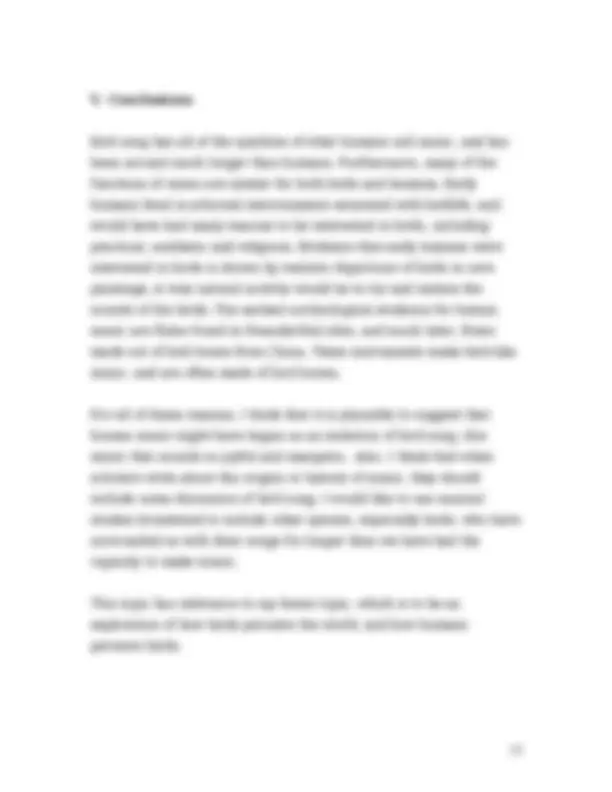

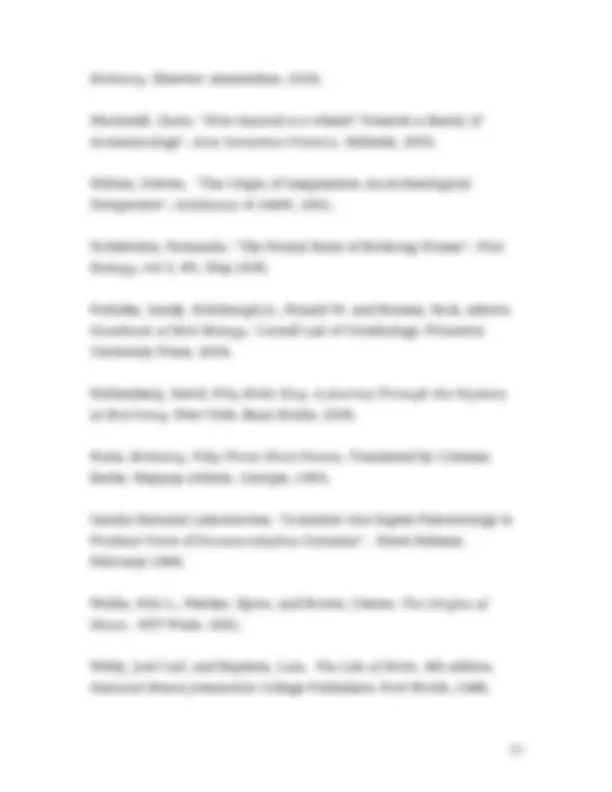
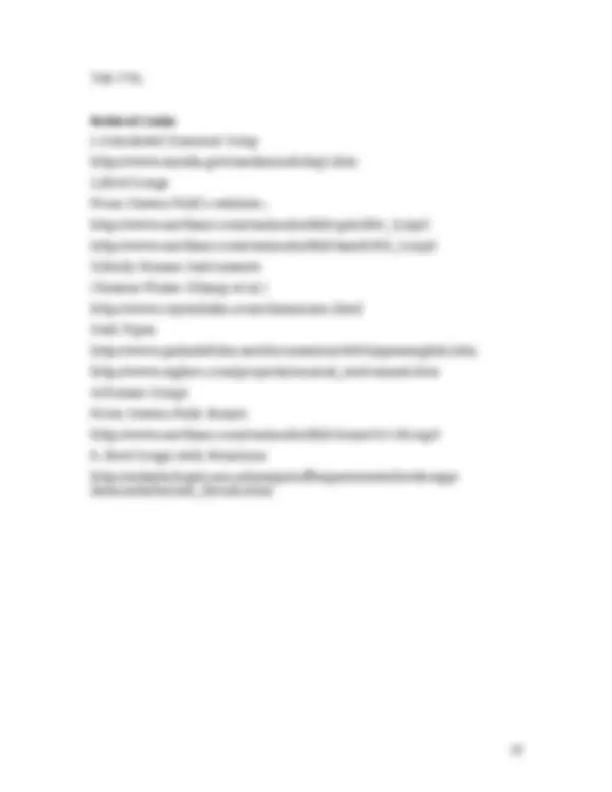


Study with the several resources on Docsity

Earn points by helping other students or get them with a premium plan


Prepare for your exams
Study with the several resources on Docsity

Earn points to download
Earn points by helping other students or get them with a premium plan
Community
Ask the community for help and clear up your study doubts
Discover the best universities in your country according to Docsity users
Free resources
Download our free guides on studying techniques, anxiety management strategies, and thesis advice from Docsity tutors
Material Type: Paper; Class: Recent Methods and Approaches to Digital Arts and Culture; Subject: Digital Arts and New Media; University: University of California-Santa Cruz; Term: Fall 2006;
Typology: Papers
1 / 18

This page cannot be seen from the preview
Don't miss anything!











Lea Cox DANM 201 6 December 2006 Bird Song and the Origin of Music “Birdsong brings relief to my longing. I am just as ecstatic as they are, but with nothing to say! Please, universal soul, practice some song, or something, through me.” --Rumi I. Introduction Writing and visual art may be uniquely human, but the creation and performance of musical composition is shared with birds, as well as with insects, frogs, whales, and dolphins. Humans are said to have evolved in a forest environment permeated by the songs of birds. Our closest living genetic relative, the Chimpanzee ( Pan troglodytes ), can vocalize but does not make what most people would consider to be music. This is not the case with birds, however, who are capable of making complex and emotionally-stirring songs. These songs have inspired numerous poets, including Rumi, quoted above, who suggests that bird song is part of the universal soul of nature and has healing properties. Birds had the ability to make music long before the first human evolved. Did humans invent music, or did music predate humans? My thesis is that humans, perhaps, did not invent tonal music, but elaborated on the songs of birds. In the process of defending my thesis, I hope to add to the work of theorists and artists who challenge
the subordination of animals as less than human and counter those who reserve the capacity for creativity to humans alone. My primary method is a literature search on bird song and its parallels to human song, and to look at the earliest evidence of human music. My approach is first, to compare the similarities in bird song and human music using a musical vocabulary, considering melody, rhythm, and harmony. What is the definition of music, and how well does bird song fit this definition? There are many studies by ornithologists who consider the structural attributes of bird song (Catchpole and Slater, Marler and Slabbekoorn). However, it is the emotional characteristics bird song that humans often seek when they go out into nature. Birds have lived on Earth for more than a hundred million years and have probably been producing music for that long, as far as we know. The omnipresence of the syrinx, a unique organ birds possess for vocalization, suggests this is an ancestral trait (Cate). Birds evolved from dinosaurs, and there is some evidence that dinosaurs produced tonal sound, maybe even music, based on the types of chambers present in their skulls. Parasaurolophus left fossils including a six feet long hollow crested skull which, when examined with an MRI scan, revealed chambers that could potentially produce music. Carl Diegert, a computer scientist at Sandia National Laboratories and paleontologist Tom Williamson at the New Mexico Museum of Natural Science teamed up to produce a simulation of the sound these animals might have made, which sounds a little like a trombone (Sandia National Laboratories). This information contributed to the soundtrack of the film, Jurassic Park. The first human ancestors evolved only a few million years ago. If we
II. Is Bird song Music? According to Webster’s dictionary, music was derived from the Greek word mousika , which meant any art presided over by the Muses (symbolizing inspiration), but especially music. Music is a word that describes sound that has certain qualities. A sound wave is made up of a series of alternatively compressed and extended bands of air molecules traveling through the air (Podulka, Rohrbaugh, and Bonney). Music, like art, is difficult to define, but it is first of all sound, and requires a source, a receiver and an interpreter or processor. Human-made music usually, but not always, has pitch (frequency of vibration), rhythm (arrangement of the sounds in time), melody (a succession of pitches), and harmony (more than one simultaneous pitch). Like human music, bird song also has pitch, rhythm, melody, and can have harmony when birds duet or if you consider the overall chorus of bird songs at a particular place and time. Some birds have extensive repertoires, such as the Brown Thrasher ( Toxostoma rufum ) who has a repertoire of more than 1, songs (Wallin, Merker, and Brown) and engage in countersinging and duetting. Music is performed, by the use of the human voice, by instruments, and through dance, for other humans. Music is “embodied” (Ayer). Humans have invented notation for writing down the melodies, pitch, and harmony of music, but written music is not really music until it is performed and heard. Music can be recorded, and these recordings can be archived and shared. The first evidence for written music is from a 3,500 years old Sumerian ceramic artifact (Wallin, Merker, and Brown). Like human music, birds perform their songs for other themselves and for other birds. They also respond vocally to musical sounds they hear from other sources, such as human music and
whistles (personal observation). Their bodily movements when they sing could be construed as dance, and in every sense of the word, birdsong is “embodied”. The songs of birds can be shared and archived (by humans for humans) as audio recordings, as sonograms, and even as musical scores. Humans also make up word phrases that mimic bird songs as a mnemonic device for bird identification. Almost all existing birds, with the exception of a few pelicans, vultures, and storks, are capable of vocalization (Welty and Baptista). Birds have evolved a specialized organ, the syrinx, to produce their vocal sounds. This vocal organ is analogous to the human larynx or voice box (Catchpole and Slater). The syrinx, located at the base of the trachea, or windpipe, produces sounds by generating vibrations of air molecules as air from the lungs is forced up through the syrinx making a complex interplay between its length, diameter, tissue hardness, and the tympanic membranes, as well as air sacs in other parts of the body (Welty and Baptista). Whereas the human larynx is situated at the top of the trachea, the avian syrinx is much closer to the lungs, allowing the syrinx to access both bronchi to produce extremely complex songs (Catchpole and Slater). Similarly to the human voice, birds can modulate their songs by stretching and retracting their necks, and by opening and closing their bills (Catchpole and Slater). There are actually two different kinds of vocalization produced by birds: songs and calls. Calls are short, are usually mono- or disyllabic, and rarely involve more than 4 or 5 notes, and if longer, have no clear organization or pattern (Welty and Baptista). Songs have more than one group of notes separated by pauses, and are usually delivered primarily by the male (Welty and Baptista). The creation and performance of bird song has a strong hormonal component,
earliest human ancestors, Australopithecus afarensis , found in Ethiopia, date back to 3.2 million years ago (Mithen) and probably lived in an arboreal environment. So both birds and early humans lived in trees during prehistoric times. There was a major divergence of humans between 600,000 and 500,000 years ago, when the Neanderthals ( Homo neanderthalensis ) settled in Europe, lasting until around 45,000 years ago (Mithen). Anatomically modern humans evolved from the African lineage 30, years ago (Mithen). The earliest evidence we have so far for human- made music is a 45,000 years old Neanderthal flute found in Slovenia (Fink). This is interesting because it is debatable whether or not the Neanderthals had the ability to make words, determined by some as the position and shape of the hyoid bone, or Adams Apple. It is also interesting because there does not seem to be any visual art produced by the Neanderthals (Mithen). Although the evidence for flutes and the evidence for cave drawings are only the fragments of the past that have managed to survive, the fact that the oldest musical instrument is older than the oldest cave drawings, and that the Neanderthals may not have had the ability to form words, might suggest that music preceded both visual art and spoken words in the evolution of human imagination. Moving to more recent evidence of music in early human cultures, we find that some of the earliest Homo sapiens musical instruments are ones that can mimic birds, primarily flute-like instruments. Recently, 9,000 year old multi-note flutes made of the ulnae bones of a Red- Crowned Crane, Grus japonensis were found at an early Neolithic site of Jiahul, in the Central Yellow River Valley Province of Henan, China (Zhang, Harbottlen, Wang, and Kong). Bird bones are hollow in order to optimize the bird skeleton for flight. Thus, bird bones are ideal for
making musical instruments and these flutes are still playable (website where one of these flutes is played). Another example of prehistoric musical wind instruments are 4,000 year old Irish pipes found at Wicklow by Margaret Gowen. Are there any reasons why early humans might want to imitate bird song? Any modern human with the ability to hear can hear and mentally process bird songs in a natural environment. Humans are awakened by bird song at dawn, called the “Dawn Chorus”. We know that man was interested in birds at least 17,000 years ago because of depictions of birds on the Lascaux Cave in Southern France. Birds are present in the iconography and mythology of virtually every world culture (Podulka, Rohrbaugh, and Bonney), and are often some of the most powerful beings, such as the falcon-headed Egyptian god Horus. This interest could have come from many sources: birds as food; bird skin and colorful bird feathers as textiles and decoration; the magical powers of flight; mystery of migrations; intriguing behavior and movements; and beautiful songs (Welty and Baptista). The ability to fly, the figural adornment with colorful feathers, and the ability to make seemingly effortless songs that are both complex and pleasing and these would be qualities that an early human might envy and try to imitate. Having established the early associations of prehistoric man and birds, I would like to turn to evidence from historical ethnic groups that lived until recently without a heavy influence from European culture. What are the associations of music and birds in some of these cultures? The Australian Aboriginals are believed to have lived in isolation in Australia for 40,000 years (Fletcher) and developed some unique musical instruments, the didgeridoo, the bullroarer, and the gumleaf. It is unknown how long these instruments have been in
can think of human examples: 5.To proclaim the sex of an individual; 6.To indicate vigor and dominance in an individual; 7.To advertise for and to allure a mate; 8.To establish sovereignty over territory; 9.To stimulate and synchronize sex behavior; 10.To entice offspring to eat; 11.To strengthen the pair bond. The first four that I have listed do not seem to be functions shared with humans. Welty and Baptista list 10 Social Functions of Bird Song : 1.To intimidate or drive away enemies or competitors; 2.To space out birds of the same species in a given environment; 3.To convey information, as about enemies and food; 4.To serve as a ìpasswordî for species identification; 5.To rally a flock for collective action; 6.To hold a flock together, as in dense foliage or during nocturnal migration; 7.To pass on cultural traditions to the next generation; 8.To educate offspring and newcomers; 9.To teach young their speciesí song; 10.To announce the emotional state or mood of a bird. I can think of examples for humans for all of these social functions, if you substitute a social group for species. Finally, Welty and Baptista listed 5 Individual Functions: 1. To discharge nervous energy or provide emotional release; 2. To identify one individual from another; 3.To perfect song through practice; 4.To permit flight in dark caves through echolocation; 5.”And that some birds may sing from a sense of well-being, or simply “for the joy of it” should not arbitrarily be ruled out!” Again, I think that human examples could be found that match all of these individual functions. This last individual function, “for the joy of it”, is what makes bird song so attractive to humans. It seems to be a celebration of life, one that humans would like to share. There is a contemporary musician, David Rothenberg, who plays music in nature with birds, trying to
engage them in his imitations and improvisations based on their music. Instead of applying a mechanistic scientific approach that relies on anatomical avian dissection to the question “Why do Birds Sing”, he tries to learn from the birds themselves through their music. People who observe birds in this more natural and holistic way are probably experiencing birds in a way that is more similar to that of early humans. Since the focus of this paper is the origin of human music, it is important to speculate on why early humans might have been inclined to sing or to play a flute. Try and imagine what it might have been like to live in a forest environment saturated with bird song (and insect song). Early humans would go to sleep and wake up to these musical sounds. Would they find these sounds as joyful and energizing as we do? If they could reproduce these sounds, they could “energize” the community. In addition to bird songs, the behavior of birds could be observed and a creative mind might try to imitate and perform some of these sounds and movements. The drawings of birds on the Lascaux and other prehistoric caves are representational and took a great deal of effort and observation. Those same talents might be applied to the representation of bird song through voice and musical instruments such as flutes. The presence of flute-like instruments in so many different cultures worldwide suggests that there is something universal about music. Playing music is “play”, it is totally engaging, it makes people feel good, and it is a celebration of life. The fact that the qualities of music are found in other species such as birds, whales, dolphins, and insects suggests that there is something even deeper than human to the universality of music. In addition to its communication aspects, music creates sound waves and resonances that can vibrate cells and
V. Conclusions : Bird song has all of the qualities of what humans call music, and has been around much longer than humans. Furthermore, many of the functions of music are similar for both birds and humans. Early humans lived in arboreal environments saturated with birdlife, and would have had many reasons to be interested in birds, including practical, aesthetic and religious. Evidence that early humans were interested in birds is shown by realistic depictions of birds in cave paintings. A very natural activity would be to try and imitate the sounds of the birds. The earliest archeological evidence for human music are flutes found in Neanderthal sites, and much later, flutes made out of bird bones from China. These instruments make bird-like music, and are often made of bird bones. For all of these reasons, I think that it is plausible to suggest that human music might have begun as an imitation of bird song, this music that sounds so joyful and energetic. Also, I think that when scholars write about the origins or history of music, they should include some discussion of bird song. I would like to see musical studies broadened to include other species, especially birds, who have surrounded us with their songs for longer than we have had the capacity to make music. This topic has relevance to my thesis topic, which is to be an exploration of how birds perceive the world, and how humans perceive birds.
Bibliography Ayer, Vijay S. Microstructures of Feel, Macrostructures of Sound: Embodied Cognition in West African and African-American Music. PhD Dissertation, U.C. Berkeley, 1998) Catchpole, C.K. and Slater, P.J.B. Bird Song. Biological Themes and Variations. Cambridge University Press. 1995. Cate, Carel Ten. “Birdsong and evolution”. Chapter 10. Marler and Slabbekoorn, editors. Nature’s Music. The Science of Birdsong. Elsevier: Amsterdam. 2004. Feld, Steven. "The Boy Who Became a Muni Bird". Sound and Sentiment: Birds, Weeping, Poetics, and Song in Kaluli Expression. University of Pennsylvania Press: Philadelphia. 1982. 20-43. Fink, Bob. “The Oldest Song in the World”. Archaeologia Musicalis (Study Group on Music Archaeology, Feb., 1988), pp. 98-100. Fletcher, Neville H. “The Didjeridu, The Bullroarer And The Gumleaf”. Acoustics Australia, Vol 31 (2), August , 2003. Gowen, Margaret. “Unique prehistoric musical instrument discovered in Co. Wicklow”. Company Report, Margaret Gowen & Co., Ltd., 2004. http://www.mglarc.com/projects/musical_instrument.htm. Mache, Francois-Bernard. Music, Myth and Nature. New York: Harwood Academic Publishers: New York, 1992. Marler, Peter and Slabbekoorn, Hans. Nature ís Music. The Science of
Zhang, Juzhong. Harbottlen, Garman. Wang, Changsui. and Kong, Zhaochen. “Oldest Playable Musical Instrument Found At Jiahu Early Neolithic Site In China”. Nature: 401(6751), Sep 23, 1999, 366-. http://www.shakuhachi.com/K-9KChineseFlutes-Nature.html OTHER INFORMATIVE REFERENCES Allen, Colin: Animal Consciousness. 1995. http://plato.stanford.edu/entries/consciousness-animal/. Elliot, Lang. Music of the Birds: A Celebration of Bird Song. NatureSound Studio: New York. 1999. Fisher, John Andrew. “What the Hills are Alive With: In Defense of the Sounds of Nature”. Chapter 13. Ed. Allen Carlson and Arnold Berleant. The Aesthetics of Natural Environments. Broadview Press: Toronto. 2004. Gardner, Tim, et al. Phys. Rev. Lett. 2001 87 208101. Hagen, Edward H. and Bryant, Gregory A. “Music and Dance as a Coalition Signaling System”. Human Nature, Vol. 14 , No. 1, 2003, 21-
James, Jamie: The music of the spheres. Music, Science and the Natural Order of the Universe. Abacus: London 1993. Jokela, Viivi. “Animal Music: Music as a Universal Phenomenon”(on
website). Kilmer, Anne Draffkorn, Richard L. Crocker and Robert R. Brown. Sounds from Silence. Bit Enki Publications: Berkeley, California,
Kosk, Kari. “Communication and Music”. (Music on website). Martinelli, Dario. “A Whale of a Sonata in Zoomusicology and the Question of Musical Structures”. Martinelli, Dario. “Symptomatology of a semiotic research: Methodologies and problems in zoomusicology”. Sign Systems Studies 29 :1, 2001. Mithen, Steven. The Singing Neanderthals: The Origins of Music, Language, Mind and Body. London: Weidenfeld and Nicolson, 2005. Phillips, Tony. “Bird Songs in Musical Notation”. Songs and Calls of Some New York State Birds”. 2003. http://www.math.sunysb.edu/~tony/birds/music/intro.html Podos, Jeffrey, Huber, Sarah K. and Taft, Benjamin. “Bird Song: The Interface of Evolution and Mechanism”. Annu. Rev. Ecol. Evol. Syst.